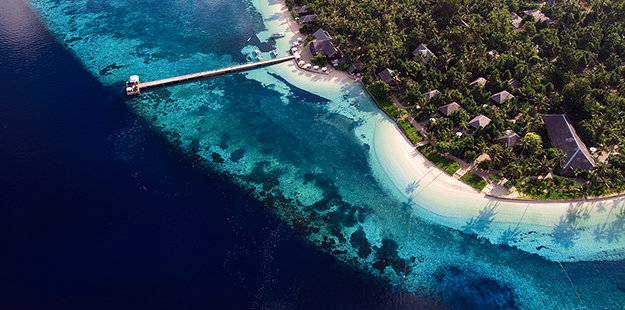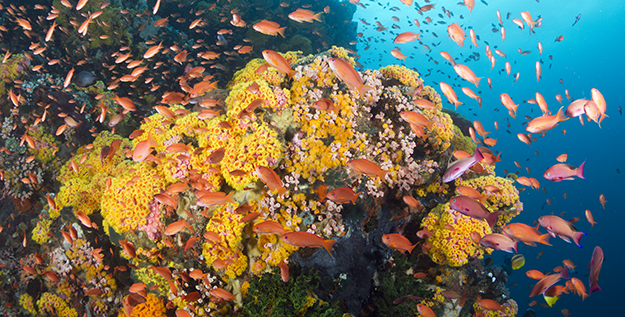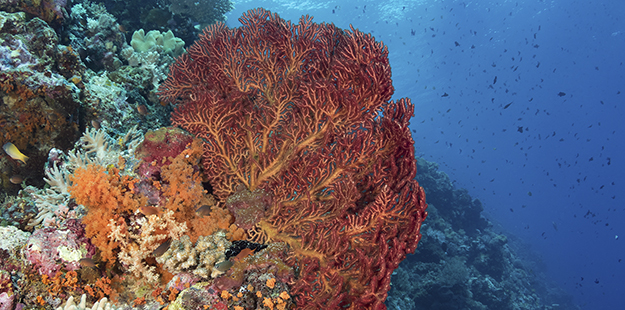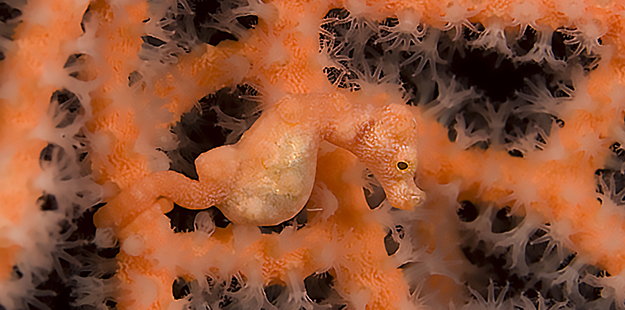Discovering Wakatobi
Discovering Wakatobi and documenting the world’s smallest seahorse
This story comes from a long-time friend and guest of Wakatobi Resort. Working alongside his late wife Denise, Larry Tackett devoted hundreds of hours to documenting the subtle details of our reefs at Wakatobi Resort. In the process, they became the first divers to witness and document the birth of their favorite subject: the pygmy seahorse. This is their story.

The Tackett’s first experienced Wakatobi Resort’s House Reef in 1997. “It continues to impress to this day,” says Larry. Photo by Didi Lotze
A new horizon
We first visited Indonesia in the summer of 1995 while working for the Arizona State University Cancer Research Institute, looking for naturally occurring anti-cancer compounds in invertebrates, principally sponges. This had been our full-time pursuit for 12 years, during which time we’d logged more than 3000 dives in a dozen different locations from the western Pacific and Indian Ocean. These locations included some of the most iconic places in dive travel, including Palau, Truk Lagoon, Papua New Guinea, Malaysia, Singapore, the Maldives, Seychelles, Comoros, and Mauritius.
After the first few dives, it was apparent that Indonesia offered unique opportunities. The concept of muck diving was just emerging and we were fortunate to be present at the ‘big bang’ of this activity. The following year we left the university to pursue marine life photojournalism work. In our first 18 months in Indonesia Denise wrote and we illustrated numerous magazine articles about Indonesian diving. It was about this time that Lorenz Mäder was scouting and then building the first facilities at what would become Wakatobi. We were fortunate enough to meet Lorenz and his wife while we were transiting through Singapore. We pitched a story on the new resort to Asian Diver, and made our first trip to Wakatobi in 1997.
As he helped Denise out of the boat Lorenz said “welcome to the end of the earth”. I will never forget that moment. We were truly on an adventure to a place where we were meant to be.
Our journey to the resort began well before dawn in Bau Bau with a 12-hour ride on a local ferry. Near sunset, we switched to a small fisherman’s outboard. Darkness fell and on we went for another two hours. Finally, a small light appeared ahead and suddenly we were running up on a beach in total darkness, save for the one small light held by Lorenz. As he helped Denise out of the boat Lorenz said “welcome to the end of the earth”. I will never forget that first moment. We were truly on an adventure to a place where we were meant to be.

The reefs surrounding Wakatobi Resort remain as pristine as when the Tackett’s first arrived in 1997, says Larry, “and in some cases actually seem in even better condition.” Photo by Walt Stearns
We were the only guests at that time. The resort consisted of one dive boat and a single main building with four guest rooms upstairs, the bathrooms downstairs and all facilities for dining, diving and support under that same roof. But what Wakatobi initially lacked in infrastructure was more than made up for by what awaited in the surrounding waters, and especially the House Reef, which astounded us right from the first dive, and continues to impress to this day. Equally memorable was the warmth and hospitality of Lorenz and the resort staff.
Tiny finds
Denise was always fascinated by the behaviors of small marine life, and kept detailed notes of her observations. When we arrived in Indonesia she was truly in her element. There were so very many fishes and invertebrates we had never seen before, and at this time there were very few marine life identification books, particularly for the Indonesian area. The world’s first pygmy seahorse (Hippocampus bargibanti) was discovered in the 1970’s, a picture was taken and added to an identification book, and then the animal was pretty much forgotten. Then in 1997, H. bargibanti was rediscovered in Bali and then Lembeh Strait by observers such as Maureen Shimlock and Burt Jones. These diminutive and well-camouflaged creatures lived on sea fans we had swam by multiple times. Once we learned what to look for, pygmy finds were made with increasing regularity.

Sea fans, on which pygmies live, are highly abundant on the sloping and vertical faces of Wakatobi’s reefs, including the House Reef. Photo by Walt Stearns
From the first, Denise was enthralled with these amazing, tiny animals, so much so that she would spend entire dives observing them and noting their behavior. She would do multiple dives to the same fans at different times of day to see if there was a difference in behavior (there was). We even went diving during the night and early morning. She was hooked and contacted the world’s experts on pygmy seahorses to offer her observations. BBC Magazine published several of our pictures of the pygmies. They became the poster critters for the marine life world. Everyone wanted to see and photograph them.
In 1997 we spent several months observing and photographing pygmies. On a dive on the Mawali, a WW II shipwreck, we located a pygmy seahorse on a small orange sea fan on the stern of the ship. We knew that the H. bargibanti pygmies were reddish in color, and lived on one specific species of red sea fan. Here was an orange pygmy on an orange sea fan. We took pictures and sent them off to the seahorse experts who said that it was probably just a color variation of H. bargibanti. Denise continued to observe this one animal and subsequently found other orange fans that also hosted orange pygmies. As she continued to observe it became obvious that this pygmy seahorse was smaller, thinner, and much more active than H. bargibanti.

A pregnant male (Hippocampus denise), also known as Denise’s pygmy seahorse. Go to page 2 to watch the original video of a Denises’s pygmy giving birth. Photo by Larry Tackett
We were relatively certain that the tiny orange creatures were something new, but the experts were not convinced. This changed when a doctoral student, Sara Lourie, from McGill University and Project Seahorse, visited as part of her regional research project. She had never seen a pygmy seahorse in the wild, and spent several days with Denise seeing both the red and orange pygmies. After many hours of diving and pouring over images and behavioral notes, she agreed that the orange one might be a new species. A subsequent DNA analysis confirmed the orange pygmy was indeed a new species, and the world had its second pygmy seahorse. To honor Denise’s contribution and efforts the new species was named Hippocampus denise, or as it has more commonly become known – Denise’s pygmy, the ‘Littlest Seahorse’. Dr. Sara Lourie and Dr. Jack Randall authored the scientific paper that described the new species.

A new private airstrip cut travel time from Bali to less than three hours when the Tackett’s returned for their 2nd visit in 2003. Photo by David Morgan
An amazing moment
Our second visit to Wakatobi Resort came in 2003, and we were immediately impressed by the changes. A new airstrip cut travel time from Bali to less than three hours, and the resort had expanded to include a number of beachfront bungalows. There was a jetty, larger dive boats, more guests and more staff. On our arrival Lorenz again had special words for Denise. “You won’t believe it,” he told her, “Women are arriving with high heels and purses.” Ah, what a difference a few years can make.
The 2003 trip came shortly after our first book Reef Life was published and Hippocampus denise was officially named and recognized by the scientific community. Denise remained dedicated to learning more about the pygmies in general, and took every advantage of opportunities to dive and observe them. From our first trip to Wakatobi, we knew the House Reef was impressive for both the variety and sheer numbers of marine life it sustained. So we did not go on the first boat dive of our trip, and instead dove right from the jetty. We quickly found two sea fans a short distance apart at a depth of 60 feet; one held a H. bargibanti, the other held several H. denise. Denise made observations as I took some photos of each. We continued to check these fans for several days, and determined that the males were growing as their eggs developed.


